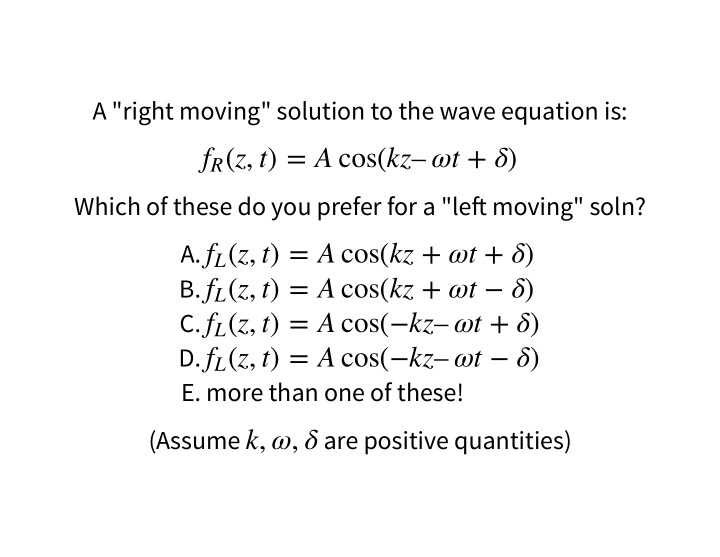



A "right moving" solution to the wave equation is: f R ( z , t ) = A cos( kz – ω t + δ ) Which of these do you prefer for a "le fu moving" soln? A. f L ( z , t ) = A cos( kz + ω t + δ ) B. f L ( z , t ) = A cos( kz + ω t − δ ) C. f L ( z , t ) = A cos( − kz – ω t + δ ) D. f L ( z , t ) = A cos( − kz – ω t − δ ) E. more than one of these! (Assume are positive quantities) k , ω , δ
Two di ff erent functions and are solutions of f 1 ( x , t ) f 2 ( x , t ) the wave equation. ∂ 2 ∂ 2 f 1 f = ∂ x 2 c 2 ∂ t 2 Is also a solution of the wave equation? ( A f 1 + B ) f 2 A. Yes, always B. No, never C. Yes, sometimes depending on and f 1 f 2
Two traveling waves 1 and 2 are described by the equations: y 1 ( x , t ) = 2 sin(2 x – t ) y 2 ( x , t ) = 4 sin( x – 0.8 t ) All the numbers are in the appropriate SI (mks) units. Which wave has the higher speed? A. 1 B. 2 C. Both have the same speed
Two impulse waves are approaching each other, as shown. Which picture correctly shows the total wave when the two waves are passing through each other?
A solution to the wave equation is: f ( z , t ) = A cos( kz – ω t + δ ) What is the speed of this wave? Which way is it moving? If is small (and >0), is this wave "delayed" or δ "advanced"? What is the frequency? The angular frequency? The wavelength? The wave number?
A solution to the wave equation is: f ( z , t ) = Re [ A e i ( kz – ω t + δ ) ] What is the speed of this wave? Which way is it moving? If is small (and >0), is this wave "delayed" or δ "advanced"? What is the frequency? The angular frequency? The wavelength? The wave number?
A complex solution to the wave equation in 3D is: ˜ ˜ e i ( k ⋅ r − ω t ) f ( r , t ) = A What is the speed of this wave? Which way is it moving? Why is there no ? δ What is the frequency? The angular frequency? The wavelength? The wave number?
Recommend
More recommend